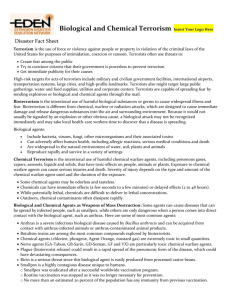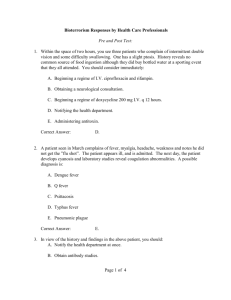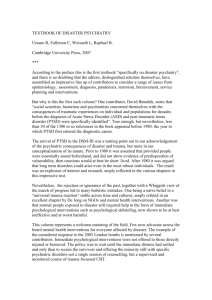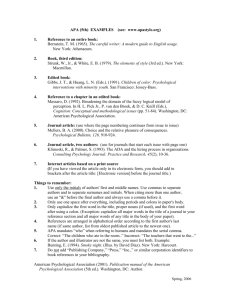Information for Primary Care Clinicians
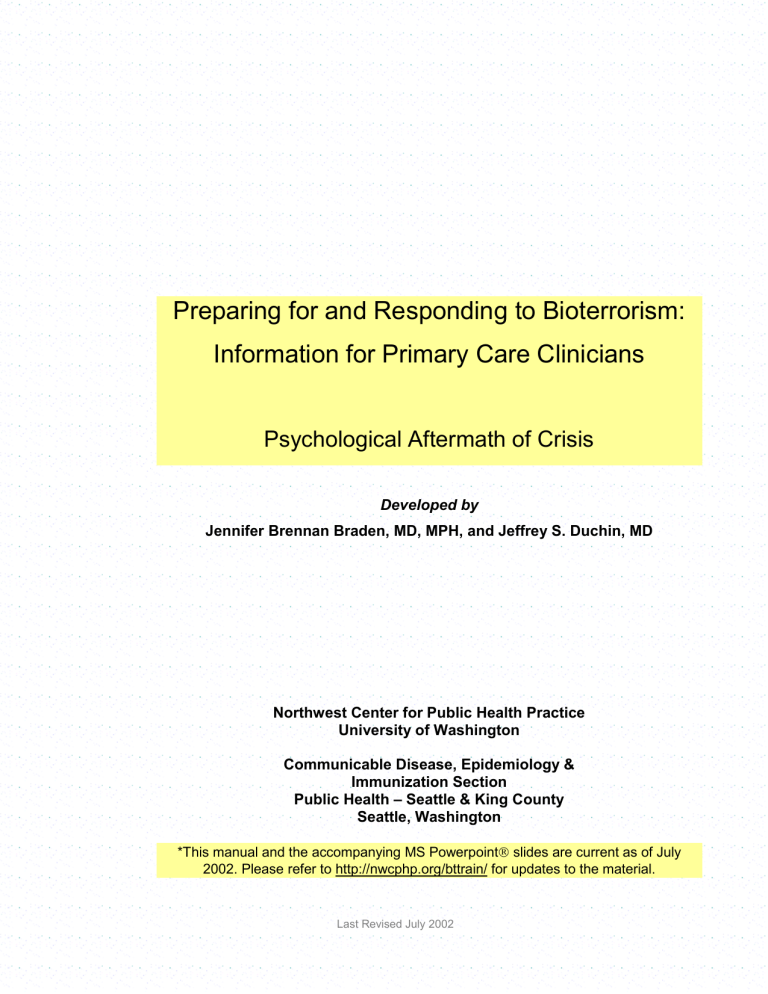
Preparing for and Responding to Bioterrorism:
Information for Primary Care Clinicians
Psychological Aftermath of Crisis
Developed by
Jennifer Brennan Braden, MD, MPH, and Jeffrey S. Duchin, MD
Northwest Center for Public Health Practice
University of Washington
Communicable Disease, Epidemiology &
Immunization Section
Public Health – Seattle & King County
Seattle, Washington
*This manual and the accompanying MS Powerpoint
slides are current as of July
2002. Please refer to http://nwcphp.org/bttrain/ for updates to the material.
Last Revised July 2002
Acknowledgements
This manual and the accompanying MS PowerPoint
slides were prepared for the purpose of educating primary care clinicians in relevant aspects of bioterrorism preparedness and response. Instructors are encouraged to freely use all or portions of the material for its intended purpose. The following people and organizations provided information and support in the development of this curriculum.
Project Coordinator
Patrick O’Carroll, MD, MPH
Northwest Center for Public Health Practice, University of Washington, Seattle, Washington
Centers for Disease Control and Prevention; Atlanta, GA
Lead Developer
Jennifer Brennan Braden, MD, MPH
Northwest Center for Public Health Practice, University of Washington, Seattle, Washington
Scientific Content Development
Jennifer Brennan Braden, MD, MPH
Northwest Center for Public Health Practice, University of Washington, Seattle, Washington
Jeffrey S. Duchin, MD
Communicable Disease Control, Epidemiology and Immunization Section, Public Health – Seattle & King
County
Division of Allergy and Infectious Diseases, University of Washington, Seattle, Washington
Design and Editing
Judith Yarrow
Health Policy Analysis Program, University of Washington, Seattle, Washington
Additional technical support provided by
Jane Koehler, DVM, MPH
Communicable Disease Control, Epidemiology and Immunization Section, Public Health – Seattle & King
County
Ed Walker, MD
Department of Psychiatry, University of Washington, Seattle, Washington
Contact Information
Northwest Center for Public Health Practice
School of Public Health and Community Medicine
University of Washington
1107 NE 45 th St., Suite 400
Seattle, WA 98105
Phone: (206) 685-2931, Fax: (206) 616-9415
Last Revised July 2002
Table of Contents
About This Course ................................................................................... 1
How to Use This Manual .......................................................................... 2
Psychological Aftermath of Crisis ............................................................. 3
Learning Objectives (Slide 4) .......................................................................... 4
Key Concepts of Disaster Mental Health (Slides 5-6) ..................................... 5
Psychological Responses to Disaster & Trauma (Slides 7-13) ...................... 7
Children & Adolescents (Slides 9-13) ....................................................... 8
Psychological Responses Following a Biological Terrorist Attack
(Slides 14-15) ............................................................................................. 10
Factors Influencing Response to and Risk of Psychiatric Sequelae
Following a Traumatic Event (Slides 16-20) .............................................. 11
Role of the Primary Care Provider (Slides 21-22) ........................................ 13
Stress Management for Health Care Providers (Slide 23) ........................... 14
Abnormal Stress Responses (Slides 24-28) ................................................. 14
Summary of Key Points (Slides 29-31) ......................................................... 16
Resources (Slide 32) .................................................................................... 16
In Case of an Event (Slides 33-34) ........................................................ 17
References ............................................................................................ 18
Last Revised July 2002
Psychological Aftermath 1
About This Course
“Preparing for and Responding to Bioterrorism: Information for Primary Care
Clinicians” is intended to provide primary care clinicians with a basic understanding of bioterrorism preparedness and response, how the clinician fits into the overall process, and the clinical presentation and management of diseases produced by agents most likely to be used in a biological attack. The course was designed by the Northwest Center for Public Health Practice in Seattle, Washington, and Public Health – Seattle & King County.
The course incorporates information from a variety of sources, including the
Centers for Disease Control and Prevention, the United States Army Medical
Research Institute in Infectious Disease (USAMRIID), the Working Group on
Civilian Biodefense, Public Health - Seattle & King County, and the Washington
State Department of Health, among others (a complete list of references is given at the end of the manual). The course is not copyrighted and may be used freely for the education of primary care clinicians.
Course materials will be updated on an as-needed basis with new information
(e.g., research study results, consensus statements) as it becomes available. For the most current version of the curriculum, please refer to: http://nwcphp.org/bttrain/.
Last Revised July 2002
2 Preparing for and Responding to Bioterrorism
How to Use This Manual
This manual provides the instructor with additional useful information related to the accompanying MS PowerPoint
slides. The manual and slides are divided into four major sections: Introduction to Bioterrorism, Bioterrorism Preparedness and
Response, Diseases of Bioterrorist Potential, and Psychological Aftermath of Crisis. Learning objectives precede each section, and a list of resources is given at the end of each section. Four slide sets comprise the section on the diseases of bioterrorist potential: Anthrax, Smallpox, Plague and Botulism, and Tularemia and Viral
Hemorrhagic Fevers. Each disease slide set contains the same introductory material on the critical agents at the beginning, and the same list of resources at the end. Instructors who want to skip this introductory material can use the navigation pages provided in the Plague and Botulism and Tularemia and Viral Hemorrhagic Fever modules (click the section you want to go to), or the custom show option in the Anthrax and Smallpox modules (go to “Custom Shows” under the “Slide Show” option on the MS PowerPoint
toolbar; select “Anthrax/Smallpox, skip intro”).
Links to Web sites of interest are included in the lower right-hand corner of some slides and can be accessed by clicking the link while in the “Slide Show” view.
Blocks of material in the manual are summarized in the “Key Point” sections to assist the instructor in deciding what material to include in a particular presentation.
A Summary of Key Points is indicated in bold, at the beginning of each section.
The slide set can be presented in its entirety, in subsections, or as an overview, depending on the level of detail included. The entire course was intended to be presented in a six- to seven-hour block of time, divided into one- to three-hour blocks according to instructor/audience preference. For instructors who want to present a less detailed, “overview” course, suggestions for more abbreviated presentations are incorporated into the modules. These latter options are built into the slide set, and can be accessed by going to “Custom Shows” (under the “Slide Show” option on the MS PowerPoint
task bar).
Last Revised July 2002
Psychological Aftermath 3
Psychological Aftermath of Crisis
Summary of Key Points:
(Listed in slides 29-31)
1. The psychological response and long-term effects following a traumatic event are influenced by an individual’s unique combination of health, developmental level, resources, and experiences.
2. Anxiety responses are most likely following a BT attack, but depressive symptoms, PTSD/ASD, and substance use may also occur.
3. Most individuals will function adequately, but a few will need psychological or medical intervention.
Last Revised July 2002
4 Preparing for and Responding to Bioterrorism
Learning Objectives
(Slide 4)
The learning objectives for this session are:
1. Know the potential psychological manifestations of a bioterrorist attack/threat on members of the community
2. Know what factors influence risk perception
3. Identify at-risk groups for psychiatric sequelae following trauma
Many of the potential manifestations of a bioterrorist attack or threat are similar to those following a natural disaster or other form of trauma. This session, therefore, discusses general concepts of disaster psychiatry and response to trauma, as well as issues specific to bioterrorism events.
Last Revised July 2002
Psychological Aftermath
Section 1: Key Concepts of Disaster Mental Health
(Slides 5-6)
Key Point
1. Psychological effects following a disaster extend beyond just the injured individuals and, to a certain degree, are normal and expected.
There are two aspects to disaster trauma – the effects on the individual and the effects on the community as a whole. Individual effects of disaster trauma include the physical and psychological consequences of those injured (or infected, in the case of a BT attack), as well as psychological consequences of the injured person’s loved ones. Individuals with no direct connection to the trauma other than awareness can experience psychological symptoms as well, especially in the case of terrorism, where events often occur without warning and thus leave people anticipating future events. Disasters can affect the physical resources – human and material – of a community, as well as the behavior and cohesive nature of the community.
5
Last Revised July 2002
6 Preparing for and Responding to Bioterrorism
Disasters stress the physical and emotional resources of people, but most people function adequately and may need only temporary assistance with problems of living brought about by the disaster (i.e., financial assistance, temporary accommodations, etc.). Psychological reactions to a disaster or trauma are normal, and it is important for a clinician not to label a patient with a diagnosis prematurely. At the same time, most people will not seek mental health services following a disaster; therefore primary care clinicians should be alert to signs of abnormal stress responses and psychopathology in their patients.
Last Revised July 2002
Psychological Aftermath
Section 2: Psychological Responses to Disaster and Trauma
(Slides 7-13)
Key Points,
Slides 7-14
1. Normal responses to trauma and disaster include depression,
PTSD/anxiety symptoms, and behavioral changes.
2. Anxiety and uncertainty predominate following a biological attack.
3. The response of children to trauma and disaster reflects their developmental level.
Some of the possible psychological and behavioral responses to disaster and trauma are listed in slides 7-13. Note that depressive symptoms, somatization, and
PTSD/anxiety symptoms are normal reactions following trauma and disaster and do not necessarily imply pathology (unless
DSM IV criteria are met or symptoms cause significant impairment in normal functioning).
7
Last Revised July 2002
8 Preparing for and Responding to Bioterrorism
Children & Adolescents
Children (slides 9-13) are a particularly vulnerable population following a traumatic event. They have fewer skills and less experience in life than adults. They have had fewer opportunities and time to develop coping mechanisms and rely on their parents/care givers to keep them safe.
Many of the signs of distress in children are similar to those seen in adults. Distress may manifest itself differently in children, however, depending on their developmental level.
Last Revised July 2002
Psychological Aftermath
Developmentally specific responses to trauma are outlined in the following slides for school-age children (slide 11) and adolescents (slide 12).
Slide 13 gives advice for parents to help children cope after trauma. It is important for both adults and children to be able to talk openly, with someone they trust, about their feelings and concerns, following a traumatic event.
Last Revised July 2002
9
10 Preparing for and Responding to Bioterrorism
Psychological Responses Following a Biological Terrorist Attack
(Slides 14-15)
Many of the psychological responses following a bioterrorist attack will be similar to those following other disasters and traumas.
Individuals and communities will grieve over the loss of loved ones to disease caused by the agents and may feel a loss of safety in their community. Fear and anxiety are likely to be the predominant emotions, however.
The challenge for clinicians will be to determine the patient’s risk and likelihood of exposure and to differentiate symptoms due to infection from symptoms due to anxiety.
Slide 15 is included to help explain why anxiety and fear may be so great following a biological attack (or even just a threat of attack).
Many factors influence how people perceive, and are willing to tolerate risk.
People are willing to tolerate a much greater risk if it is taken on voluntarily and under their control than if it is imposed upon them and out of their control.
Risks are also better tolerated when distributed fairly, are from a trusted source, and will ultimately result in some benefit to the individual.
Natural and familiar risks are perceived as better than those that are man-made or exotic.
A bioterrorist attack is imposed, controlled by others, unfairly distributed, of no benefit to the victims, and from an untrusted source. Biological agents are natural, but their deliberate release into the environment is a man-made event; and most of the agents with BT potential would be considered “exotic” by individuals in the community.
Last Revised July 2002
Psychological Aftermath 11
Section 3: Factors Influencing Response to and Risk of Psychiatric Sequelae Following a Traumatic Event
(Slides 16-20)
Key Point
1. Internal and external factors, pre and post-event, may make some individuals more at risk for long-term adjustment problems and psychiatric sequelae following a traumatic event.
Factors influencing an individual’s response to a traumatic event are listed in slide 16 and include innate, predisposing factors, factors pertaining to the event/exposure, and factors pertaining to the time following the event.
Coping with stress requires appraisal of both the stressor and the individual’s available resources/coping mechanisms, and development of a coping strategy.
The magnitude and severity of the stressor, the strength and availability of resources, and the ability to develop a coping strategy are each important in determining the individual’s risk for negative sequelae. These basic concepts are reflected in the list of factors increasing one’s risk for long-term adjustment problems and psychiatric problems (slides 17-
20).
Last Revised July 2002
12 Preparing for and Responding to Bioterrorism
Last Revised July 2002
Psychological Aftermath
Section 4: Role of the Primary Care Provider
Key Point
1. The roles of the primary care provider following disaster or trauma include differentiating abnormal from normal stress responses, providing treatment when indicated, and providing information and support to patients.
The role of the primary care provider in the psychological aftermath of trauma is outlined in slides 21 and 22.
The first responsibility of the clinician is to determine when medical treatment is indicated. Cognitive and physical symptoms may each be of either psychological or biological origin. Psychological symptoms may require short-term treatment with medications if the symptoms interfere with the individual’s ability to function. Individuals meeting DSM-IV criteria, or who are otherwise exhibiting abnormal responses to stress, will need appropriate treatment, either through the primary care clinician or via referral to a mental health care provider.
Risk communication is another important role for the primary care provider. Anxiety may be due to perceived risks that are not true risks, and education may serve to relieve unnecessary fears.
Active listening is another important role for the clinician. Talking through one’s emotions is an important part of the recovery process.
Last Revised July 2002
13
14 Preparing for and Responding to Bioterrorism
Stress Management for Health Care Providers
(Slide 23)
Clinicians also need to be aware of their own and their employees’ stress responses, especially if they are providing direct care to victims.
Section 5: Abnormal Stress Responses
(Slides 24-28)
Slide 24 lists possible abnormal stress responses that may occur following a disaster or trauma, and require medical or psychological intervention.
Slides 25-28 review the DSM-IV criteria for
Post-traumatic Stress Disorder, and Acute
Stress Disorder. The latter is the more likely diagnosis; PTSD is an important diagnosis but a less common one than ASD.
Last Revised July 2002
Psychological Aftermath
Last Revised July 2002
15
16 Preparing for and Responding to Bioterrorism
Summary of Key Points
Resources
Last Revised July 2002
Psychological Aftermath
In Case of An Event…
The next two slides highlight Web-based resources valuable to clinicians during a BT event. Most of the links have been presented previously in the resources following the different sections of this curriculum. They are included here again because they contain answers to questions clinicians may have during the course of an event – updates on disease investigations and threats, current testing, treatment and prophylaxis recommendations, and contact numbers for additional information and reporting.
17
Last Revised July 2002
18 Preparing for and Responding to Bioterrorism
References
General Bioterrorism Information and Web sites
American College of Occupational and Environmental Medicine. Emergency
Preparedness/Disaster Response. January 2002. http://www.acoem.org/member/trauma.htm
Centers for Disease Control and Prevention. Public Health Emergency Preparedness and Response. January 2002. http://www.bt.cdc.gov
Center for the Study of Bioterrorism and Emerging Infections at Saint Louis
University School of Public Health. Home Page. January 2002. http://www.bioterrorism.slu.edu
Historical perspective of bioterrorism. Wyoming Epidemiology Bulletin;5(5):1-2,
Sept-Oct 2000.
Journal of the American Medical Association. Bioterrorism articles. April 2002. http://pubs.ama-assn.org/bioterr.html
Johns Hopkins Center for Civilian Biodefense Studies. Home Page. January
2002. http://www.hopkins-biodefense.org/
Pavlin JA. Epidemiology of bioterrorism. Emerging Infect Dis [serial online]
1999 Jul-Aug; 5(4). http://www.cdc.gov/ncidod/EID/eid.htm
Tucker JB. Historical trends related to bioterrorism: an empirical analysis.
Emerging Infect Dis [serial online] 1999 Jul-Aug; 5(4). http://www.cdc.gov/ncidod/EID/eid.htm
Washington State Department of Health. Home Page. January 2002. http://www.doh.wa.gov
Bioterrorism Preparedness and Response
Centers for Disease Control and Prevention. Biological and chemical terrorism: strategic plan for preparedness and response. MMWR 49(RR-4): 1-14.
Federal Bureau of Investigation. Home Page. January 2002. http://www.fbi.gov/
Federal Emergency Management Agency & United States Fire Administration-
National Fire Academy. Emergency Response to Terrorism: Self-Study
(ERT:SS) (Q534), June 1999. http://training.fema.gov/EMIWeb/crslist.htm.
Geberding JL, Hughes JM, Koplan JP. Bioterrorism preparedness and response: clinicians and public health agencies as essential partners. JAMA
2002;287(7):898-900.
Koehler J, Communicable Disease Control, Epidemiology & Immunization Section, Public Health – Seattle & King County. Surveillance and Preparedness for
Agents of Biological Terrorism (presentation). 2001.
O’Carroll PW, Halverson P, Jones DL, Baker EL. The health alert network in action. Northwest Public Health 2002;19(1):14-15.
Last Revised July 2002
Psychological Aftermath
Diseases of Bioterrorist Potential
Advisory Committee on Immunization Practices (ACIP). Use of smallpox (vaccinia vaccine), June 2002: supplemental recommendation of the ACIP.
Bolyard EA, Tablan OC, Williams WW, Pearson ML, Shapiro CN, Deithman
SD. HICPAC. Guideline for infection control in health care personnel, 1998. Am
J Infect Control 1998;26:289-354. http://www.bt.cdc.gov/ncidod/hip/GUIDE/infectcont98.htm
Breman JG & Henderson DA. Diagnosis and management of smallpox. N Engl J
Med 2002;346(17):1300-1308.
Centers for Disease Control and Prevention. Smallpox Response Plan and Guidelines (Version 3.0). Sep 21, 2002.
Centers for Disease Control and Prevention. CDC Responds: Smallpox: What
Every Clinician Should Know, Dec. 13th, 2001.
Webcast: http://www.sph.unc.edu/about/webcasts/
Centers for Disease Control and Prevention. CDC Responds: Update on Options for Preventive Treatment for Persons at Risk for Inhalational Anthrax, Dec 21,
2001. Webcast: http://www.sph.unc.edu/about/webcasts/
Centers for Disease Control and Prevention, American Society for Microbiology
& American Public Health Laboratories. Basic Diagnostic Testing Protocols for
Level A Laboratories. http://www.asmusa.org/pcsrc/biodetection.htm#Level%20A%20Laboratory%20
Protocols
CDC. Considerations for distinguishing influenza-like illness from inhalational anthrax. MMWR 2001;50(44):984-986.
CDC. Notice to readers update: management of patients with suspected viral hemorrhagic fever – United States. MMWR. 1995;44(25):475-79.
CDC. The use of anthrax vaccine in the United States. MMWR 2000;49(RR-
15):1-20.
CDC. Update: investigation of bioterrorism-related anthrax --- Connecticut,
2001. MMWR 2001;50(48):1077-9.
CDC. Vaccinia (smallpox) vaccine: recommendations of the Advisory Committee on Immunization Practices (ACIP). MMWR 2001;50(RR-10):1-25.
Chin J, ed. Control of Communicable Diseases Manual (17th ed), 2000: Washington DC.
Duchin JS, Communicable Disease Control, Epidemiology & Immunization Section Public Health – Seattle & King County. Bioterrorism: Recognition and Clinical Management of Anthrax and Smallpox (presentation). 2001.
Fenner F, Henderson DA, Arita I, Jezek Z, Ladnyi ID. Smallpox and its Eradication, 1988:Geneva.
Franz DR, Jarhling PB, Friedlander AM, McClain DJ, Hoover DL, Bryne R et al.
Clinical recognition and management of patients exposed to biological warfare agents. JAMA 1997;278:399-411.
Last Revised July 2002
19
20 Preparing for and Responding to Bioterrorism
Frey SE, Newman FK, Cruz J, Shelton WB, Tennant JM, Polach T et al. Doserelated effects of smallpox vaccine. N Engl J Med 2002;346(17):1265-74.
Fulco CE, Liverman CT, Sox HC, eds. Gulf War and Health: Volume 1. Depleted Uranium, Pyridostigmine Bromide, Sarin, and Vaccines, 2000: Washington
DC. URL: http://www.nap.edu.
Jernigan JA, Stephens DS, Ashford DA, Omenaca C, Topiel MS, Galbraith M et al. Bioterrorism-Related Inhalational Anthrax: The First 10 Cases Reported in the
United States. Emerging Infect Dis [serial online] 2001 Jul-Aug; 7(6): 933-44. http://www.cdc.gov/ncidod/EID/eid.htm
Mandel GL, Bennett JE, Dolin R, eds. Principles and Practice of Infectious Diseases (5th ed), 2000: Philadelphia.
Michigan Department of Community Health Bureau of Epidemiology. Clinical
Aspects of Critical Biologic Agents: web-based course, May 2001. http://www.mappp.org/epi/info/
New England Journal of Medicine. Smallpox Issue. April 25, 2002; 346(17).
Plotkin SA & Orenstein WA, eds. Vaccines (3 rd ed), 1999: Philadelphia.
Rosen P, Barkin R, Danzl DF, et al, eds. Emergency Medicine: Concepts and
Clinical Practice (4th ed), 1998: St. Louis, MO.
Rotz LD, Khan AS, Lillebridge SR. Public health assessment of potential biological terrorism agents. Emerging Infect Dis [serial online] 2002;8(2):225-230. http://www.cdc.gov/ncidod/EID/eid.htm.
US Army Medical Research Institute of Infectious Diseases. USAMRIID’s Medical Management of Biological Casualties Handbook (4th ed). Fort Detrick, MD:
2001.
Zajtchuk R, Bellamy RF, eds. Textbook of Military Medicine: Medical Aspects of Chemical and Biological Warfare. Office of The Surgeon General Department of the Army, United States of America. http://ccc.apgea.army.mil/reference_materials/textbook/HTML_Restricted/index.
htm
Working Group on Civilian Biodefense
Consensus Recommendations
Arnon SS, Schechter R, Inglesby TV, Henderson DA, Bartlett JG, Ascher MS, et al. Botulinum toxin as a biological weapon: medical and public health management. JAMA 2001;285:1059-1070.
Borio L, Inglesby T, Peters CJ, Schmalijohn AL, Hughes JM, Jarhling PB et al.
Hemorrhagic fever viruses as biological weapons: medical and public health management. JAMA. 2002;287:2391-2405.
Dennis DT, Inglesby TV, Henderson DA, MD, Bartlett JG, Ascher MS, Eitzen E, et al. Tularemia as a biological weapon: medical and public health management.
JAMA 2001;285:2763-73.
Last Revised July 2002
Psychological Aftermath
Henderson DA, Inglesby TV, Bartlett JG, Ascher MS, Eitzen E, Jahrling PB, et al. Smallpox as a biological weapon: medical and public health management.
JAMA 1999;281(22): 2127-2137.
Inglesby TV, Dennis DT, Henderson DA, MD, Bartlett JG, Ascher MS, Eitzen E, et al. Plague as a biological weapon: medical and public health management.
JAMA 2000;283:2281-90.
Inglesby TV, Henderson DA, Bartlett JG, Ascher MS, Eitzen E, Friedlander AM, et al. Anthrax as a biological weapon: medical and public health management.
JAMA 1999;281:1735-45.
Inglesby TV, O’Toole T, Henderson DA, Bartlett JG, Ascher MS, Eitzen E et al.
Anthrax as a biological weapon, 2002: updated recommendations for management. JAMA 2002;287:2236-2252.
Psychological Aftermath of Crisis
Agency for Toxic Substances and Disease Registry: A Primer on Health Risk
Communication Principles and Practices. http://www.atsdr.cdc.gov/HEC/primer.html
American Psychiatric Association: Diagnostic and Statistical Manual of Mental
Disorders, Fourth Edition, Text Revision. Washington, DC, American Psychiatric Association, 2000.
American Psychiatric Association. Home Page. January 2002. http://www.psych.org
Department of Health and Human Services, Substance Abuse and Mental Health
Services Administration Center for Mental Health Services. Disaster manual for mental health and human services workers in major disasters. http://www.mentalhealth.org/cmhs/EmergencyServices/fpubs.asp
Holloway HC, Norwood AE, Fullerton CS, Engel CC, Ursano RJ. The threat of biological weapons: prophylaxis and mitigation of psychological and social consequences. JAMA 1997;278:425-7.
Norwood AE, Ursano RJ, Fullerton CS. Disaster psychiatry: principles and practice. Psychiatr Q 2000 Fall;71(3):207-26.
Walker E, University of Washington Department of Psychiatry and Behavioral
Sciences. Bioterrorism and Mental Health Issues (presentation). December 8,
2001.
21
Last Revised July 2002
22 Preparing for and Responding to Bioterrorism
Last Revised July 2002
Psychological Aftermath 23
Last Revised July 2002
24 Preparing for and Responding to Bioterrorism
Last Revised July 2002

